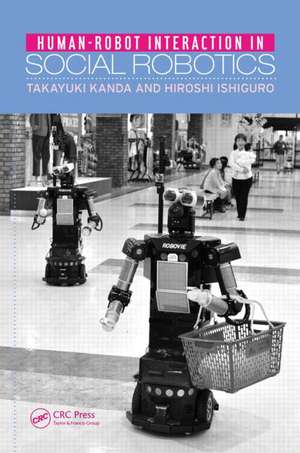Human-Robot Interaction in Social Robotics
Autor Takayuki Kanda, Hiroshi Ishiguroen Limba Engleză Hardback – 26 sep 2012
Taking a networked robot approach, the book examines how robots work in cooperation with ubiquitous sensors and people over telecommunication networks. It considers the use of social robots in daily life, grounding the work in field studies conducted at a school, train station, shopping mall, and science museum. Critical in the development of network robots, these usability studies allow researchers to discover real issues that need to be solved and to understand what kinds of services are possible.
The book tackles key areas where development is needed, namely, in sensor networks for tracking humans and robots, humanoids that can work in everyday environments, and functions for interacting with people. It introduces a sensor network developed by the authors and discusses innovations in the Robovie humanoid, including several interactive behaviors and design policies.
Exploring how humans interact with robots in daily life settings, this book offers valuable insight into how robots may be used in the future. The combination of engineering, empirical, and field studies provides readers with rich information to guide in developing practical interactive robots.
| Toate formatele și edițiile | Preț | Express |
|---|---|---|
| Paperback (1) | 598.88 lei 6-8 săpt. | |
| CRC Press – 29 mar 2017 | 598.88 lei 6-8 săpt. | |
| Hardback (1) | 1451.18 lei 6-8 săpt. | |
| CRC Press – 26 sep 2012 | 1451.18 lei 6-8 săpt. |
Preț: 1451.18 lei
Preț vechi: 1813.98 lei
-20% Nou
Puncte Express: 2177
Preț estimativ în valută:
277.69€ • 296.94$ • 231.53£
277.69€ • 296.94$ • 231.53£
Carte tipărită la comandă
Livrare economică 17 aprilie-01 mai
Preluare comenzi: 021 569.72.76
Specificații
ISBN-13: 9781466506978
ISBN-10: 1466506970
Pagini: 372
Ilustrații: 75 b/w images
Dimensiuni: 156 x 234 x 23 mm
Greutate: 0.66 kg
Ediția:New.
Editura: CRC Press
Colecția CRC Press
ISBN-10: 1466506970
Pagini: 372
Ilustrații: 75 b/w images
Dimensiuni: 156 x 234 x 23 mm
Greutate: 0.66 kg
Ediția:New.
Editura: CRC Press
Colecția CRC Press
Public țintă
Academic and Professional Practice & DevelopmentCuprins
Introduction to Network Robot Approach for Human–Robot Interaction. Field Tests—Observing People’s Reaction. Users’ Attitude and Expectations. Modeling Natural Behaviors for Human-Like Interaction with Robots. Sensing Systems: Networked Robot Approach. Shared Autonomy and Teleoperation. Learning and Adaptation.
Notă biografică
Takayuki Kanda is currently a senior researcher at ATR Intelligent Robotics and Communication Laboratories, Kyoto, Japan. His current research interests include intelligent robotics, human–robot interaction, and vision-based mobile robots. Dr. Kanda was named to serve as a steering committee co-chair of the ACM/IEEE international conference of human–robot interaction from 2010 to 2013.
Hiroshi Ishiguro has been a visiting researcher at ATR Media Information Science Laboratories since 1999, where he has developed the interactive humanoid robot, Robovie. He is also a professor in the Department of Systems Innovation, Osaka University, and a group leader at ATR Hiroshi Ishiguro Laboratory. In 2010, he served as a general co-chair of the ACM/IEEE international conference of human–robot interaction.
Hiroshi Ishiguro has been a visiting researcher at ATR Media Information Science Laboratories since 1999, where he has developed the interactive humanoid robot, Robovie. He is also a professor in the Department of Systems Innovation, Osaka University, and a group leader at ATR Hiroshi Ishiguro Laboratory. In 2010, he served as a general co-chair of the ACM/IEEE international conference of human–robot interaction.
Descriere
Social robots are a frontier research area in robotics and human–computer interaction. This book summarizes the research of the Robovie project at ATR Intelligent Robotics and Communication Laboratories, a world leader in humanoid interactive robotics. The text covers interdisciplinary topics related to interactive robots, including human behavior recognition and behavior-based control. It presents the results of field studies conducted with non-technical users in everyday environments—such as train stations and shopping malls—and discusses the implementation of robots that interact with sensors and users over a telecommunications network.










